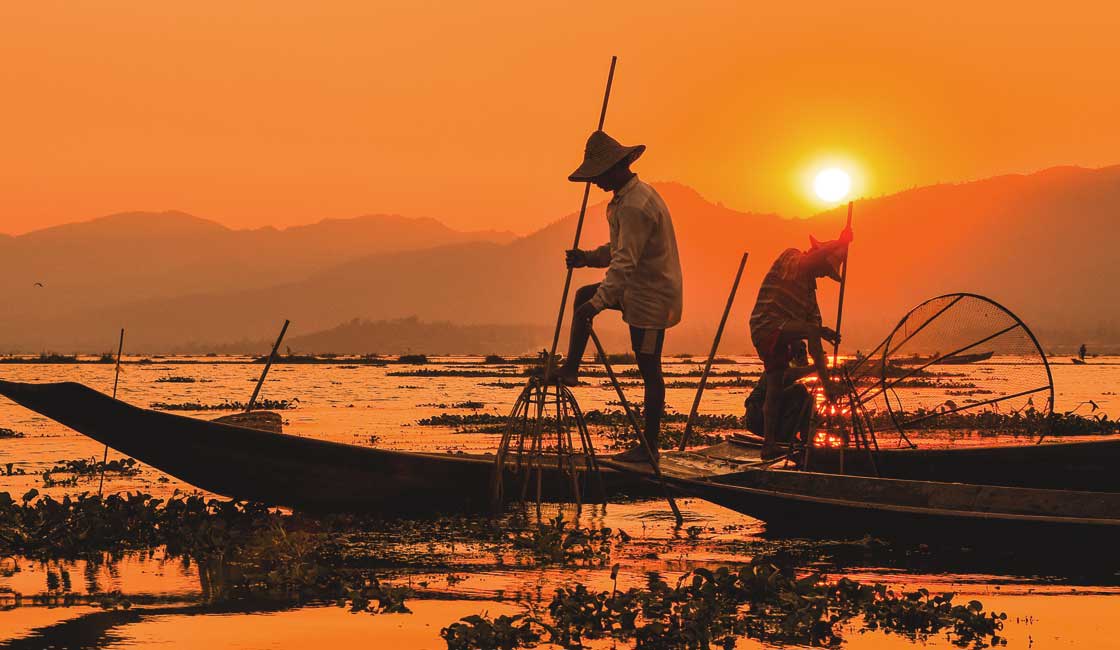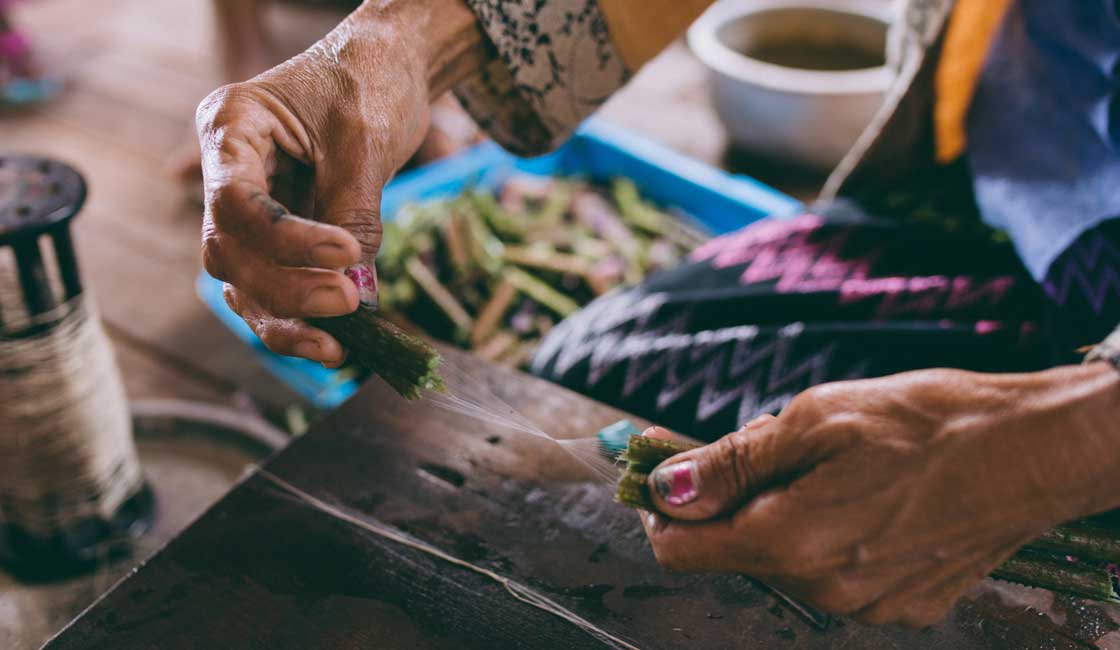
In short, absolutely! The vast Inle Lake is one of Myanmar’s most impressive natural treasures and biggest tourist draws. With stunning scenic vistas, floating gardens, picturesque stilt villages and opportunities for handicraft shopping and active adventures, it’s one Myanmar destination definitely not to be missed. Here’s an introductory guide to making the most of a trip to this unique watery world.
This shallow freshwater lake spans 45 square miles and was recently declared a UNESCO biosphere reserve for its outstanding ecological and cultural significance. Inle lake is home to thriving communities of farmers, fishermen and traders spanning many diverse ethnic groups. With floating vegetable gardens, fascinating markets, ancient monasteries and stupas galore, spending a few days exploring its shores provides an unparalleled insight into local Burmese life. No wonder this uniquely beautiful lake is one of the top 10 things to see in Myanmar.

Traditional fishing techniques
Inle Lake is located some 650 km north of Yangon in Western Shan state, bordered by Thailand and Laos. It’s surrounded by majestic green mountains and ringed by numerous small fishing villages and a couple of larger communities that serve as a base for exploring the lake. You can fly in – Hehlo airport is located 46km northwest of Inle lake – or take the 10-hour road trip from the capital.
Naturally, the best way to see Inle Lake is to take to the water, spending a few hours touring the main sights both around the shores and on the lake itself. Canoes can be hired at several places, notably at Nyaung Shwe, the launching point for most boat trips which set out every day in the early morning.
The boat trips typically visit most of the best-known sights, most of which are concentrated in the northern part of the lake. Tours can also be tailored according to your needs and preferences. Your boat driver, who also acts as a tour guide, will be happy to advise you on everything there is to see and do.

Floating gardens
Exploring Inle lake isn’t just about whisking between all the sites, but enjoying the journey and serenity of the lake itself. As you glide along its surface, you’ll pass traditional fishing communities based entirely on water. Cruise past overwater wooden stilt houses and sublime floating vegetable gardens secured to the lake bed with bamboo poles. Also be sure to admire the incredible Intha fisherfolk at work, who are most active – and photogenic – at dawn. They are renowned for their distinctive “leg-rowing” technique which they developed out of necessity as a way to negotiate the flowing marshes and thick reeds that fill the lake.
The village of Nampan on the northern shore is especially picturesque, featuring countless stilted houses and busy with locals going about their daily routines. It’s also home to one of the oldest pagodas on the lake, Alodaw Pauk, as well as one of the lake’s most notable floating gardens. Locals cultivate vegetables and flowers directly on the water using a unique method of agriculture. You’ll have the chance to step out and walk around the wobbly garden to observe more closely.

Making thread from lotus stems
1. Traditional Handicrafts
Alongside fishing and floating gardens, numerous cottage industries form an important part of the local economy. These range from silversmithing to silk weaving, cheroot (cigar) rolling to blacksmithing. Boat trips will arrange a stop at various workshops where you can observe the techniques and purchase some unique crafts.
Top of the list should be the weaving factories around Phaw Khone, where the entire community is devoted to silk, cotton and lotus root weaving, resulting in beautiful woven textiles used to fashion robes, bags, scarves and plenty more. Inle Lake has been a major weaving centre for decades and whilst the tourist trade has gathered force in recent years, a significant proportion of the crafts are still sold in local markets.
2. Pagodas and Monasteries
As with most of Myanmar, religion plays a central role in local life and numerous pagodas dot the shores of the lake. Nyaung Ohak and Shwe Inn Thein, found in the small village of Indein, are two pagodas well worth a visit. Ancient, crumbling and wonderfully atmospheric, you’ll find hundreds of densely packed stone stupas to explore. Shwe Inn Thein Paya is located at the end of a long covered walkway leading up a hill and boasts breath-taking views out across the lake.
For more incredible architecture and lake views, head to the Forest Monastery at Maing Thauk, accessible either as part of a canoe tour, or by road from Nyaung Shwe. Inle lake is also home to one of the holiest shrines in the entire state, the impressive Phaung Daw Oo Pagoda. The site attracts worshippers from across the country and features an enormous shrine complete with five gilded Buddhas. For something a little different, Nga Hpe Kyaung monastery, formerly famous for its cat jumping antics, features a beautiful heritage house, along with gardens, restaurant and an art gallery.
3. Hiking and Biking
Inle Lake is surrounded by mountainous landscape that make it one of Myanmar’s premier hiking spots. Most visitors opt for a two to three day trek from the lake to the community of Kalaw. Led by a guide, you’ll hike through hills and forests, pass friendly hill tribe communities and stop at viewpoints offering panoramic perspectives.
Another popular inland adventure involves hiring a bicycle from Nyaung Shwe and making your way around the eastern side of the lake towards Maing Thauk. Peddle through the beautiful Burmese countryside peppered with small villages, sugarcane plantations and even a collection of hot springs. Many visitors choose to combine this trip with a visit to the popular Red Mountain Estate vineyard. The estate produces some of Asia’s best wines and is particularly memorable at sunset, boasting magnificent views over Inle lake and its surrounds.
With so much to do and see, as well as learn, visitors to Myanmar’s Inle Lake’s tranquil waters will not be disappointed.
While Rainforest Cruises aim to provide accurate and up-to-date information, we make no representations as to the accuracy or completeness of any information herein or found by following any link on this site. Rainforest Cruises cannot and will not accept responsibility for any omissions or inaccuracies, or for any consequences arising therefrom, including any losses, injuries, or damages resulting from the display or use of this information.




